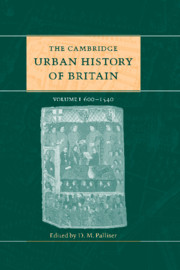Book contents
- Frontmatter
- Part I Introductory
- Part II The early middle ages 600–1300
- Part III The later middle ages 1300–1540
- Part IV Regional surveys
- 21 Regional introduction (England and Wales)
- 22(a) The South-East of England
- (b) The South-West of England
- (c) The Midlands
- (d) East Anglia
- (e) Northern towns
- (f) Wales and the Marches
- 23 Scotland
- Part V Conclusion
- Appendix: Ranking lists of English medieval towns
- Select bibliography
- Index
- References
(c) - The Midlands
from 22(a) - The South-East of England
Published online by Cambridge University Press: 28 March 2008
- Frontmatter
- Part I Introductory
- Part II The early middle ages 600–1300
- Part III The later middle ages 1300–1540
- Part IV Regional surveys
- 21 Regional introduction (England and Wales)
- 22(a) The South-East of England
- (b) The South-West of England
- (c) The Midlands
- (d) East Anglia
- (e) Northern towns
- (f) Wales and the Marches
- 23 Scotland
- Part V Conclusion
- Appendix: Ranking lists of English medieval towns
- Select bibliography
- Index
- References
Summary
The Midland region contains unspectacular countryside, except at its western and northern margins, and varied geology. The dominating features of its geography are three of the major drainage basins of England: the Severn, the Trent and the Ouse/Nene/Welland (Map 22.9). These river systems gave shape to sub-regions, provided easy transport routes to other parts of the country and ensured the prosperity of towns located on their banks and crossing places. The West Midlands is focused on the Severn, Warwickshire Avon, Wye and Teme valleys, whilst the Wiltshire Avon and the upper Thames form its southern bounds. The shire towns (except Stafford) were all located beside these rivers (Map 4.1). So, too, was the entrepôt trading centre of Bristol which became the largest city of the region since it was able to serve a large part of the South-West too. The Severn was navigable to Welshpool on the Welsh border. In contrast, the Trent was navigable only a few miles upstream from Nottingham, which is the only shire town located beside it, though Stafford, Leicester and Derby are on tributaries. The entrepôt of the Trent valley is Hull, which served the whole Yorkshire Ouse basin of the North of England too. The rivers draining the South-East Midlands reached the North Sea via the fenlands and their successful navigation depended on constant maintenance. Boston and Lynn were the major port towns, but the shire towns are also located on the principal rivers.
- Type
- Chapter
- Information
- The Cambridge Urban History of Britain , pp. 609 - 638Publisher: Cambridge University PressPrint publication year: 2000
References
- 2
- Cited by

